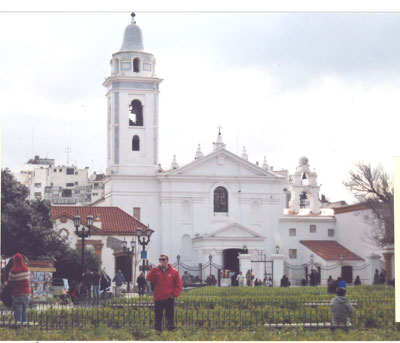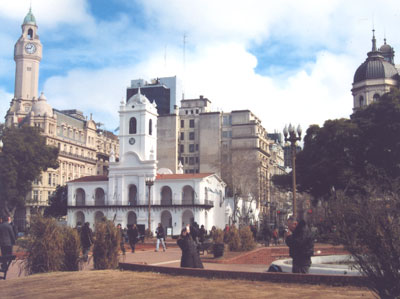Buenos Aires’ colonial past — two masterpieces
This item appears on page 61 of the September 2011 issue.
by Julie Skurdenis
Buenos Aires’ history stretches back almost 500 years. In 1536 King Carlos I of Spain sent Pedro de Mendoza to the Rio de la Plata in what is now northeastern Argentina to establish a fort. This fort was the first site of what eventually became Buenos Aires.
Forty-four years later, Juan de Garay “refounded” the city just a mile and a half from the original site, naming it Ciudad de la Santisima Trinidad y Puerto de Santa Maria de los Buenos Ayres, or City of the Holy Trinity and Port of Holy Mary of the Favorable Winds — Buenos Aires, for short.
De Garay’s city plan was a checkerboard pattern centered on a main square. Today, this is the Plaza de Mayo, one of Buenos Aires’ prime tourist sites. Visitors travel there to see the Casa Rosada, the rose-colored Presidential Palace, built in the 18th century atop an earlier fortress.
Nearby is the Cathedral, originally built in 1745 but remodeled 100 years later in neoclassical style with a ponderous colonnade and pediment. General José de San Martín, liberator of Argentina from Spanish rule, lies in a massive sarcophagus in a side chapel within the church’s baroque interior.
The Cabildo
At the opposite end of the square from the Casa Rosada is a lovely white building that is considered a shrine by Argentinians. It’s called the Cabildo and is the only colonial-era building still left, more or less intact, on the Plaza de Mayo.
Built in 1608, the Cabildo was rebuilt in 1725 and looks, today, 285 years later, essentially the way it looked then except for two truncations because of street construction. The Cabildo was at the center of the 1810 revolution that declared independence from Spain, hence its status today as Argentina’s national shrine.
Inside is a small historic museum with a sampling of paintings and furniture from the colonial era. Behind the building is a beautiful patio with a fountain and trees. In another patio to the left, a small crafts fair is held from 11 to 6 on Thursdays and Fridays. Hours for the National Historic Museum are 10:30 to 5 Tuesday to Friday and 11:30 to 6 Sunday.
Recoleta gem
Another colonial-era gem built at about the same time as the Cabildo is the Basílica Nuestra Señora del Pilar, Our Lady of the Pillar. Part of a monastery for Franciscan monks founded in 1715 by King Felipe V of Spain, the church is located in Recoleta, one of Buenos Aires’ classiest neighborhoods.
Next door to the church is another of the city’s prime tourist attractions, Recoleta Cemetery, which used to be part of the 18th-century monastery complex until converted into a cemetery in 1822. Now some of Argentina’s most prominent political and military figures, as well as just the plain well-heeled, rest here in ornate mausoleums as does Maria Eva Duarte de Perón, popularly known as Evita.
The church, itself, consecrated in 1732, is very ornate yet not overpowering. The main altar, with its silver front panel, is reputedly the only such one in Buenos Aires and was carved in Bolivia in about 1750. All the side altars are in extravagant Baroque style with polychrome statues.
What makes this church unique is the three-level cloister located off the north aisle. These cloisters were once used to provide access to the church’s pulpit and bell tower, as cells for monks while the monastery was being built, and as storage for tools used in the monastery orchard (now Recoleta Cemetery).
The cloisters have now become an art museum of religious treasures from colonial days. It is worth noting the original 300-year-old brick floor and the alabaster windows admitting light but also giving privacy. The museum is open 10:30-6:15 Monday-Saturday and 2:30-6:15 Sunday. Admission is four pesos, about one dollar.
Even on the shortest visit, don’t miss the chance to see two of Buenos Aires’ colonial-era treasures, rare architectural and historic jewels in this bustling modern cosmopolitan city.
Cafés of note
To me, Buenos Aires is the quintessential city of cafés and tango. It’s why I go there as often as I do.
So much of Buenos Aires’ social life revolves around its cafés. There are many, scattered everywhere throughout the city. The best are the old-fashioned ones with carved wood walls, chandeliers and ornate mirrors. They’ve been serving coffee and pastries for generations, although most serve meals as well.
My three favorite cafés — of the dozens visited over the past 30 years — are Café Tortoni, the queen of cafés and one of the oldest, at Avenida de Mayo 825; Las Violetas, stunning with columns and stained-glass windows, at Avenida Rivadavia 3898, and La Biela, with an outdoor terrace just across from Recoleta Cemetery, at Avenida Quintana 600.
All are open long hours, usually 8 or 9 a.m. to 2 or 3 a.m. Coffee and pastry for two should average about $20 to $25. You can spend a lot less at a modern café, but you won’t be getting the history or the ambiance.
On with the show
As for tango, there are dozens of possibilities. All I’ve visited offer a good show plus an okay dinner. Almost all are pricey, averaging (on my latest trip in July/August 2010) about $200 for two people, including dinner and wine.
One I’ve gone to on each of my last four trips to Buenos Aires is El Querandi at Peru 302. The tango show and music are top-notch and the dinner served, almost as good. Including wine, which comes with the dinner, it should cost about $215 for two.
Tango shows offer spectacular, often athletic displays of tango dancing, but for just plain good tango proficiently danced, go to the streets. Young couples literally dance in the streets, passing a hat around for donations between dance numbers.
The best places to see this? El Caminito in the neighborhood La Boca on weekends; Plaza Dorrego in San Telmo on Sundays; in front of La Biela café in Recoleta on weekends, and on Florida, the pedestrian shopping street, near Galerías Pacifico and another great café, the Richmond.
BA apartments
If you stay longer than four or five days in Buenos Aires, consider renting an apartment. On our latest trip, my husband, Paul, and I rented a princely apartment in Recoleta around the corner from Avenida Alvear, Buenos Aires’ equivalent of New York City’s Fifth Avenue or Paris’ Champs Élysées.
The elegant, six-room apartment with two bedrooms, two bathrooms, computer room/study and ultrasleek well-equipped kitchen cost $4,110 for 32 days. That’s about $128 per day for luxury living — a bargain in comparison with four- or five-star hotels in Buenos Aires (and a downright steal compared with European rentals of the same caliber).
Two rental companies we’ve used on recent trips are LuxuryBA (Puerto Madero, CP 1107, Buenos Aires, Argentina; phone, in the US, 786/245-0582) and Buenos Aires Habitat (Buenos Aires; phone, in the US, 305/735-2223).


